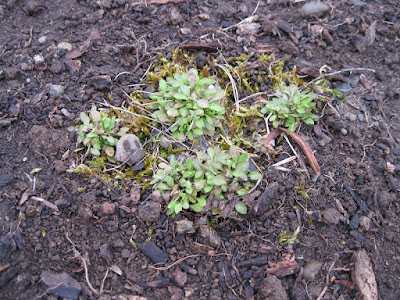How native plants are assigned names is frequently a mystery. For this flower the naming process is well documented. John Bourroughs wrote about this plant at great length. In his day the name Dog Tooth Violet was the label frequently associated with this treasure. Mr. Burroughs objected to that name on two points. First, the flower has the structure of a lily not a violet. Secondly, he could find nothing about the plant that suggested canine teeth. The mottled leaf markings reminded him of the native fish trout and the timing of the plants appearance each spring coincided with his pursuit of that fish. In his writings, he suggested that the plant be called Trout Lily and that became the plant's enduring popular name.
The single leaves pictured here portray one of the great mysteries about this plant. These leaves are rather large suggesting a mature plant but single leaved plants never flower. Only plants with two leaves produce flowers. Burroughs spent not an inconsiderable amount of time trying to solve the puzzle. He concluded that only older deeply rooted plants produced two leaves and flowers but he could find no plausible explanation for the method of a seed dropped on the forest floor's surface developing a corm that pulled itself ever deeper each year into the soil. Here we have single leaved plants by the thousands but precious few that flower. Our bedrock ridge is solidly stone. Glacial action left what we call soil heavily littered with broken stone of all sizes. We believe that the overwhelming presence of stone here prevents the Trout Lily from working its corm deeply into the ground. New plants spring from the wandering roots but plants that flower are rare here.
In this spot the soil depth exceeds six inches. The corm is deep sending up two leaves and a flower, This early flower holds an enduring allure on us. Our rare arbutus flowers earlier while the trout lily is common but mostly without flowers. These yellow blossoms made their first appearance in our shade garden today. We moved the plants from our woods into our garden several years ago. They multiplied like weeds but no flowers were seen until today. We also found several flowering plants in our woods. That too is unusual. We commonly find headless flower stems. My guess is that the turkeys eat the flowers and the insects that alight there. It is likely that we happened on these blossoms on the first day that they were open.
The view from the rear clearly shows the flowers structure and its insect companion.
The view from the front is heavily pollen laden. I owe a huge debt of gratitude to John Bourroughs and his written words. They awakened in me a desire and an interest to explore and enjoy the small parts of the natural world that surrounds us all.


















































